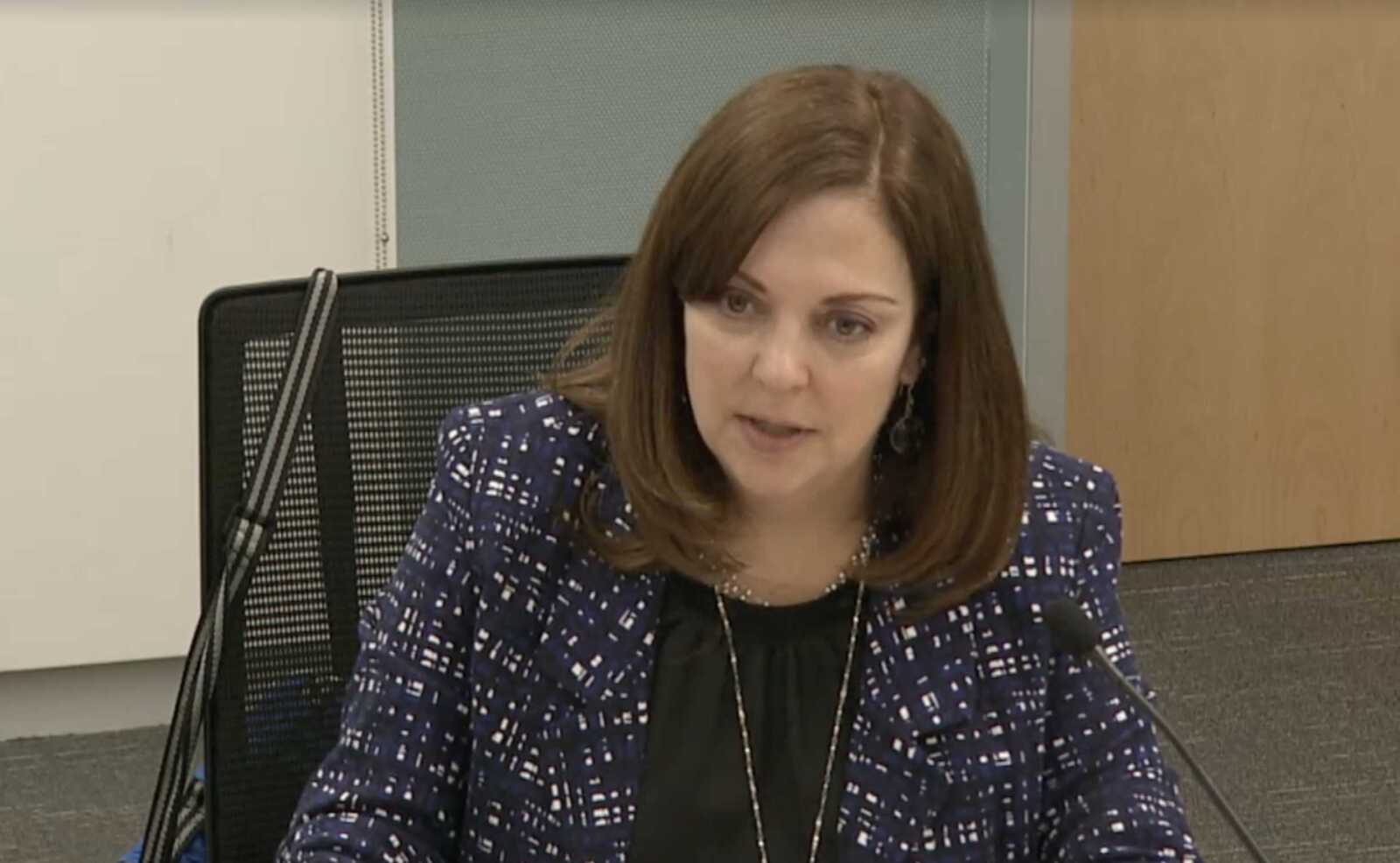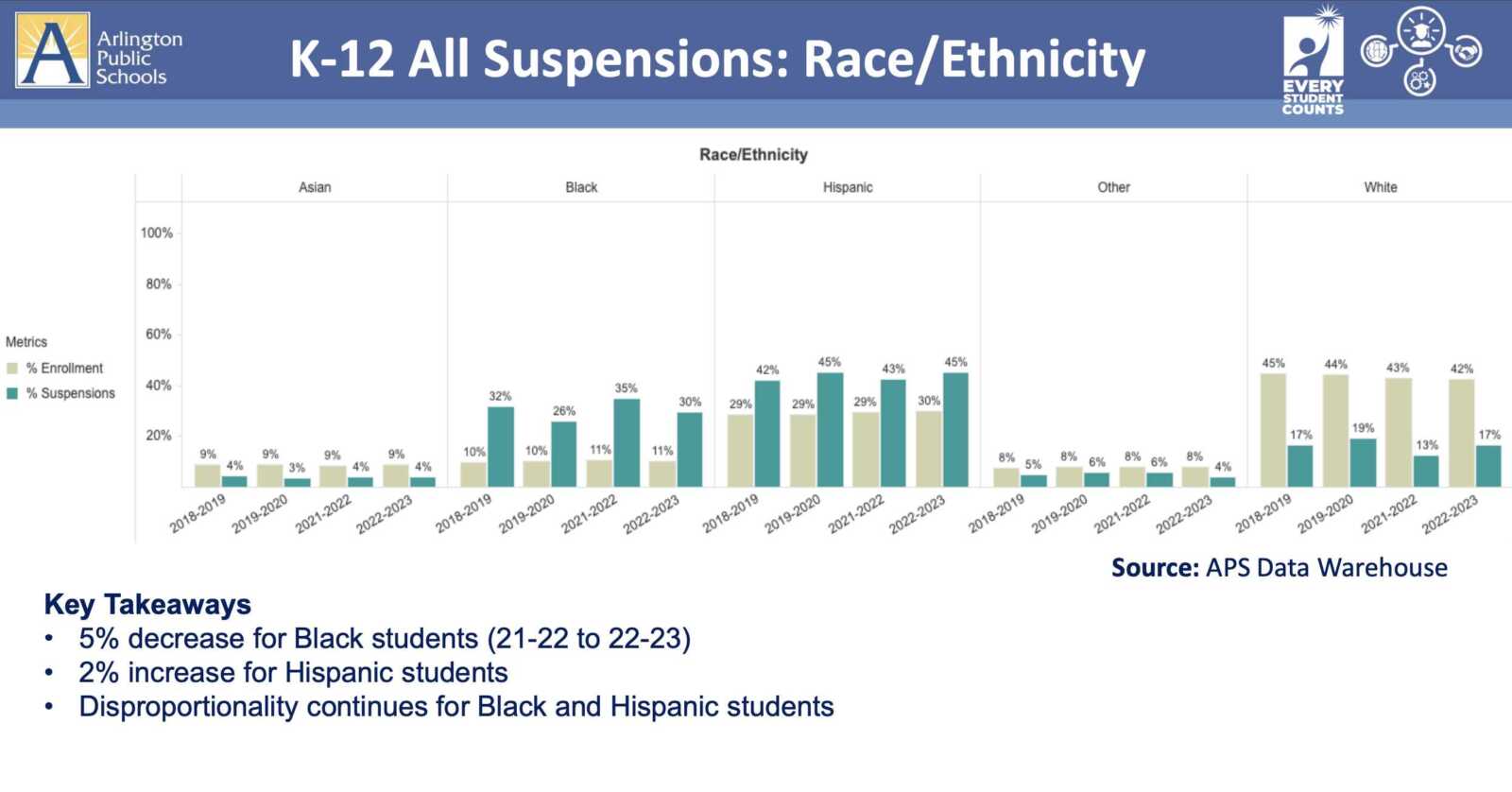
(Updated at 6:35 p.m.) Black and Hispanic students remain more likely to be suspended from Arlington Public Schools than their peers, according to new data.
Specifically, Black students make up 11% of students yet 30% of suspensions, while Hispanic students make up 30% of the population and 45% of suspensions, per a presentation to the Arlington School Board yesterday (Tuesday).
Meanwhile, students with disabilities and those learning English are also over-represented in suspension rates. APS says they are, respectively, 2.5 and 1.5 times more likely to be suspended than their counterparts.
APS has made some inroads, noting a 5-percentage point drop in suspensions of Black students, a 4-percentage point drop among students with disabilities and a 2-percentage drop among males. Suspensions rose 2 percentage points for Hispanic students and females and remain unchanged for English-language learning students.
Disproportionate suspensions along race and ethnicity, ability and sex have long existed in APS, which has recently taken steps to reduce these gaps and improve its school climate more broadly.
This includes staff training in implicit biases and the root causes of problematic student behavior as well as in how to prevent crises using de-escalation. Also, the School Board two years ago voted to remove School Resource Officers from school grounds to tackle disproportionate arrest rates among non-white students.
More recently, APS hired six Deans of Students this school year to address student behaviors at Yorktown, Washington-Liberty and Wakefield high schools as well as three middle schools. Middle schools in particular have seen problematic student behavior, including fights and verbal threats to teachers.

Chief Diversity, Equity and Inclusion Officer Julie Crawford described to the School Board how school administrators plan to tackle suspension rates.
“We would like to continue to focus on building our alternatives to suspension at the school level,” she said, adding that the new deans work “to proactively program and build relationships using instructional time, as opposed to removing our students from the school.”
Sometimes, students have to be removed from school. APS says the top reasons for out-of-school suspensions are disruptive behavior, followed by attendance issues — such as skipping class — and drug offenses. The top two reasons for in-school suspensions are the same, followed by fighting.
Tiffany Woody-Pope, dean of students at Thomas Jefferson Middle School, emphasized the importance of good staff-student relationships.
“I think the more that we are intentional about developing our interpersonal relationships with our students, the more comfort they’ll feel in classrooms — so they won’t necessarily have to be classified as ‘disruptive behavior,'” she said.
Seeing “disruptive behavior” top charts set off alarm bells for School Board member Mary Kadera.
“Disruptive behavior gives me a little heartburn… because historically, and broadly, outside of Arlington, ‘disruptive behavior’ has been a catch-all for a wide variety of behaviors and self-expression of students that a teacher may not like,” she said.
Crawford noted it is a broad definition with any of 17 different indicators, including disrespect and defiance.
June Prakash, the president of the teachers union, Arlington Education Association, would also like to see more daylight on “disruptive behavior,” questioning whether teachers and administrators have the ability to record a more accurate, specific reason for removing a student from class.
“Believe it or not, educators will put up with a lot before sending calling for help,” she said. “Staff often don’t feel supported, as it feels like their expertise is disregarded in the building.”
She said teachers typically have a student removed for violent or destructive behavior at the elementary level or threats of physical violence and disruption to the learning environment at the secondary level.
Regardless of the reason, the uptick in suspension rates among Hispanic students — and unchanged disproportionality for English-language learning students — concerns the Arlington Schools Hispanic Parents Association.
“We have made improvements over the past few years and to see it as going backward is heartbreaking,” the group said in a statement to ARLnow. “We look forward to working with the School Board and the Superintendent to find ways to adjust and support the crisis that the youth is going through in an effort to make sure students have opportunities to succeed and not put in places where they are being set up to fail.”
The NAACP Arlington branch’s education committee says work remains to ensure the school system is an “effective, accountable, equity-focused school system.”
“The Education Committee would like to see equity prioritized and valued consistently throughout APS and has had several conversations and meetings with the current administration on tackling this problem,” committee chair Tia Alfred told ARLnow. “The NAACP will continue to work closely with APS leadership until each student, and especially our students of color, receive the equitable treatment they deserve.”
The disability community in Arlington has long advocated for students with disabilities to learn alongside their peers, and members remain highly concerned about how punitive policies disproportionately impact students with disabilities, says former chair of Arlington Special Education Advisory Committee, David Rosenblatt.
“I believe all behavior is communication and if we’re not giving students the support they need, early and appropriately, then we’re exacerbating the situation and treating students as the problem and moving into a punitive legalistic framework is not an effective way to support people to learn skills they need to learn,” he said.
He calls for more training for general education teachers and a culture change in school buildings so students with disabilities and students of color are not held to different standards than their peers.
School Board member Bethany Zecher-Sutton says this work involves increasing engagement with parents.
“We’re lacking some community building around what parents can and should expect,” she said. “If we can we pull back the curtain a little bit to say, ‘Here’s what we’re doing’ in a way that would resonate… It isn’t as simple as ‘There’s a fight, two kids get disciplined, and we’re done.’ It’s a lot for people to absorb.”
Prakash likewise says some teachers “wish there were more conversations, from parents and administrators, about expectations while at school.”
“When an educator tells you that there is a problem, the response could be quicker,” the union leader said. “There does need to be buy in from the parent, as this can significantly delay a child receiving proper services.”
A previous version misidentified DEI Officer Julie Crawford.

